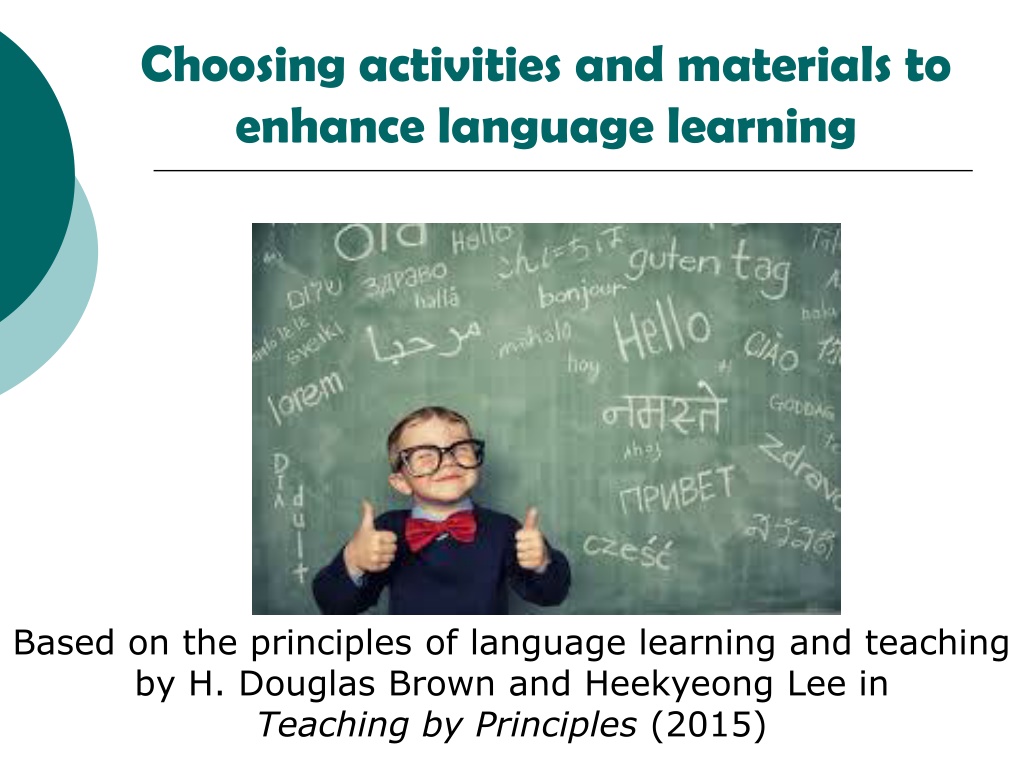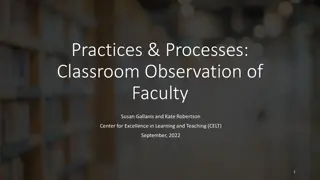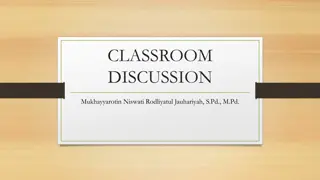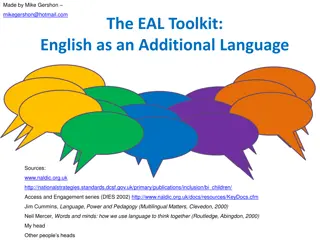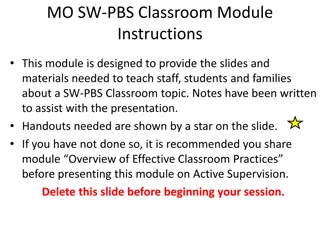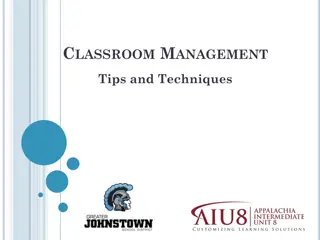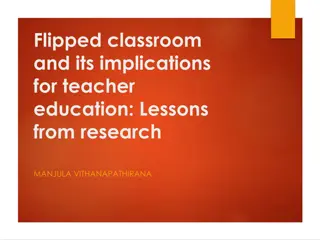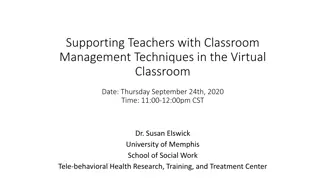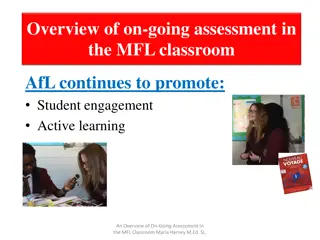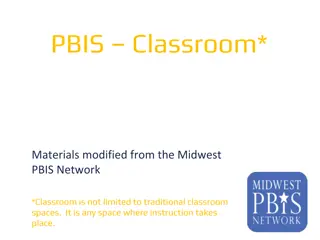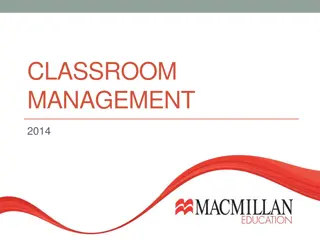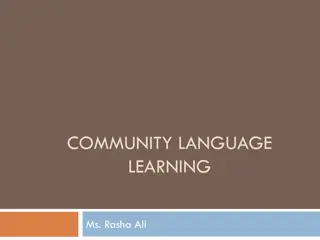Enhancing Language Learning through Effective Classroom Practices
Explore the principles of language learning and teaching by Brown and Lee in "Teaching by Principles" (2015). Discover how automaticity, transfer, and task design impact language acquisition in the classroom. Emphasize meaningful interactions, purposeful tasks, and the balance between controlled and automatic language processing. Consider the role of instructors, students, coursebooks, and curricula in directing language learning.
Download Presentation

Please find below an Image/Link to download the presentation.
The content on the website is provided AS IS for your information and personal use only. It may not be sold, licensed, or shared on other websites without obtaining consent from the author. Download presentation by click this link. If you encounter any issues during the download, it is possible that the publisher has removed the file from their server.
E N D
Presentation Transcript
Choosing activities and materials to enhance language learning Based on the principles of language learning and teaching by H. Douglas Brown and Heekyeong Lee in Teaching by Principles (2015)
In a language classroom, who directs the learning? the instructor? thecoursebook? thestudents? thecurriculum?
Principles of Language Learning and Teaching (Brown and Lee, 2015) Automaticity Identity and investment Language- culture connection Transfer Reward Self-regulation Interaction
Automaticity (Brown and Lee, 2015) Efficient second language learning involves learners progressing from controlled, limited language practice to automatic language processing. Students move toward fluency and think about language less as they progress.
Automaticity in the classroom Tasks should focus primarily on meaning, purpose and interaction. Don t overwhelm students with too much focus on language rules and form.
Compare the following beginner Croatian grammar presentations
Automaticity in the classroom Mechanical Communicative Manipulative Teacher-controlled Student-controlled
Transfer (Brown and Lee, 2015) Learners naturally seek to transfer existing knowledge and abilities to new knowledge or skills. pickleball
Transfer in the classroom (Brown and Lee, 2015) Help learners make meaningful connections between their existing knowledge and skills and the new material.
Transfer in the classroom (Brown and Lee, 2015) Cognates English - Spanish accident accidente activities actividades family familia festival festival fruit fruta FalseCognates Spanish - English embarazada pregnant ( NOT embarrassed) xito success (NOT exit)
Transfer in the classroom (Brown and Lee, 2015) Help learners make meaningful connections between their existing knowledge and skills and the new material. GREETINGS Hamid: As-salaam Alaykum Sara: Walaykum As-salaam Hamid: Labas? Sara: Culshi mzien. Inta labas? Hamid: Culshi mzien. Alhamdulilah
Transfer in the classroom (Brown and Lee, 2015) Help learners make meaningful connections between their existing knowledge and skills and the new material. As-salaam Alaykum Walaykum As-salaam Labas? Culshi mzien. Inta labas? Culshi mzien. Alhamdulilah
Transfer in the classroom (Brown and Lee, 2015) Design lessons and activities based on students backgrounds, interests, personalities, and hobbies. Avoid rote-learning and lengthy grammar explanations because they are not meaningful.
Transfer in the classroom (Brown and Lee, 2015) A group of people posing for the camera Description automatically generated Learning Arabic through songs
Reward (Brown and Lee, 2015) Reward = Better performance. The most powerful rewards are those that are intrinsically motivated. A
Reward in the classroom (Brown and Lee, 2015) Use verbal praise, encouragement, compliments, enthusiasm, and cooperative activities. Remind students of long-term rewards; help students see why they should want to study language.
Identity & Investment (Brown and Lee, 2015) r A learner s sense of self-worth is tied to their linguistic ability and students may feel awkward or threatened in the language learning environment. Good teachers compensate. To develop proficiency in a second language, learners must invest their personal time and energy in the process.
Identity & investment in the classroom (Brown and Lee, 2015) Support your students by choosing activities that challenge but don t overwhelm. Be patient, positive and sympathetic. Give students choice in what / how they learn so that they don t feel powerless.
Interaction (Brown and Lee, 2015) Learning a second language requires engaging in communicative acts with others.
Interaction in the classroom (Brown and Lee, 2015) Carefully scaffold communicative practice activities to ensure learner success. The more students feel confident, the more willing they are to take risks. Find a balance between encouraging risk taking and encouraging correctness. Image result for ordering food in chinese min. 18:12
Self-regulation (Brown and Lee, 2015) Successful learners take a pro-active approach to their learning. They set learning goals and strive toward autonomy with the teacher as a facilitator.
Self-regulation in the classroom (Brown and Lee, 2015) Raise students awareness of learning preferences, strengths and weaknesses. Help them set their own learning goals and monitor their own progress.
Howard Gardners Multiple Intelligences Theory Verbal/Linguistic Logical / Mathematical Visual / Spatial Bodily / Kinesthetic Interpersonal Intrapersonal Musical Naturalist Say it, write it Count it, analyze it Draw it Move it Lead it, share it Reflect on it Sing it, tap it out Classify it
Language-Culture Connection Successfully learning a language means learning about the culture too. (Brown and Lee, 2015)
Language-Culture Connection (Brown and Lee, 2015) Help your students understand cultural customs, values, and ways of thinking, feeling, and acting.
Education is not the filling of a pail, but the lighting of a fire. attributed to William B. Yeats
Based on these principles, you can assess the strengths and weaknesses of your lessons, coursebook, and activities. You can adjust your teaching to light a fire in your students.
Reference Brown, H.D., & Lee, H. (2015). Teaching by principles: An interactive approach to language pedagogy. Pearson Education
Cindy Rauth Cindy Rauth Academic Coordinator English Language and Cultural Studies University of Arkansas crauth@uark.edu
